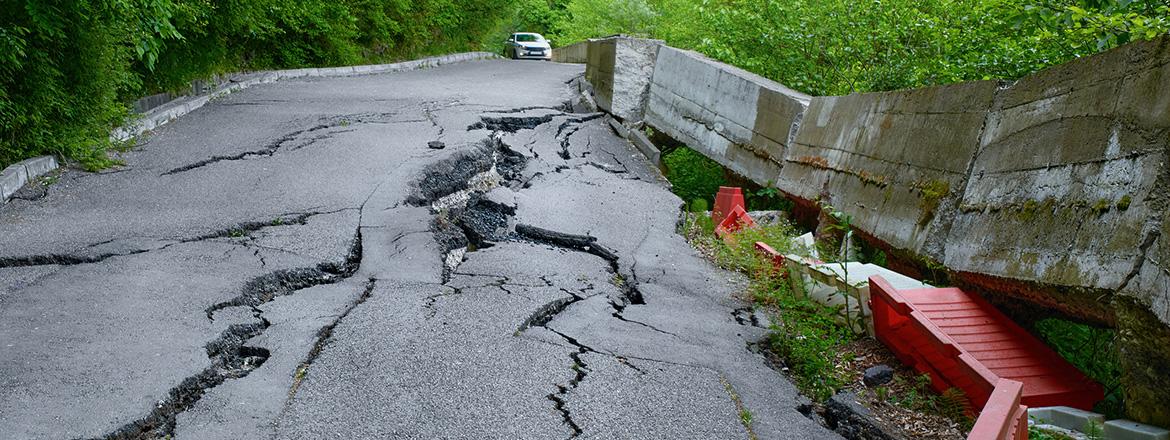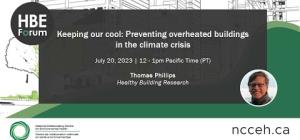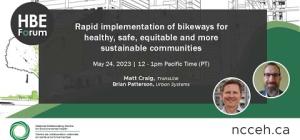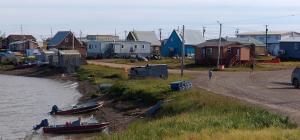
Earthquake resources for environmental public health professionals

Earthquakes result when tectonic forces cause sections of the crust to move suddenly against each other, sending out seismic waves that cause imperceptible to violent shaking on the surface. This shaking, and subsequent secondary disasters such as flooding, tsunamis, hazardous chemical spills, fires, landslides, and avalanches, create extremely complex disasters with high probability for injuries and loss of life.
Canada experiences thousands of small earthquakes every year, with only a handful in recent years resulting in substantial property damage or loss of life. However, in the much longer span of geological time, some regions of Canada (particularly coastal BC and parts of Eastern Canada) have the potential for catastrophic earthquakes that could severely challenge our public health system.
The greatest public health risk lies in densely populated centers where the bulk of the building stock was created before building codes began making incremental improvements in seismic safety. Although communities may receive alerts through Natural Resources Canada’s Earthquake Early Warning system, these warnings can only reduce harmful impacts if residents and public health practitioners are able and prepared to act.
Environmental public health (EPH) practitioners play an important role in the emergency management cycle regarding a major earthquake. This subject guide does not address the broader subject of public health system emergency preparedness, but rather the specific tools that EPH professionals may require to prepare for and respond to a catastrophic earthquake. Each of the sections below offer resources to support EPH practice areas, including assessing public health needs, restoring clean water, sanitation, and safe food; structural damage assessments; evacuations and shelter management; management of pests; management of hazardous spills that occur due to the damage; advising on clean up, and others.
Engaging the public in preparedness
Because earthquakes are unavoidable and unpredictable, preparedness is essential for avoiding loss of life. This section provides multimedia tools and resources for engaging and informing the public, particularly maps and videos that help visualize the risks and impacts of these disasters. These materials are intended to support the individual-, household-, and community-level preparedness.
- Community resilience planning guide (National Institute of Standards and Technology 2022)
This toolkit provides the framework and the materials to develop all-hazard emergency plans that are driven by the communities’ social and economic needs, which are frequently omitted from conventional approaches to preparedness.
- We’re ready! Effectiveness of community disaster preparedness workshops across different community groups in Alberta, Canada (Bogdan et al. 2021)
This article describes the results a community disaster preparedness workshop, developed and piloted in High River Alberta. The program helps communities design their own disaster preparedness plans through short lectures combined with facilitated activities that help identify members with disaster experience and useful skillsets. The group then develops a draft community disaster plan, and exercises it in a disaster simulation. After revising the plan, the final activities identify leaders and strategies to build momentum for continued engagement and implementation.
- Simplified seismic hazard map for Canada, the provinces and territories (Natural Resources Canada, 2021)
This website provides maps that show the relative likelihood of experiencing strong shaking for occupants in a 1-2-story structure. The red or “high relative hazard” areas indicate a roughly 30% chance of significant damage to a portion of 1-2-story structures within a 50-year period
- Ready Wrigley (US Centres for Disease Control and Prevention, 2020)
This webpage offers activity books, checklists, and backpack emergency cards intended to help engage children in preparedness activities for earthquakes and other disasters.
- Caltech Science Exchange (Caltech University, n.d.)
This video series created by a leading seismic research institution spotlights their world-renowned researchers in addressing some common questions and myths regarding earthquake science and preparedness, including:
- How early warning systems work;
- Best and worst structures to occupy during an earthquake;
- Impacts on urban infrastructure;
- How to make buildings more resilient;
- How to prepare a kit;
- How to drop, cover, and hold and why you should not try to run outside.
- Federal, provincial and territorial websites supporting general earthquake preparedness among the public:
- Government of Canada’s Earthquake page and general emergency preparedness guidebook
- Government of British Columbia:
- Get prepared for an earthquake page, offered in five languages
- Provincial earthquake immediate response strategy (PEIRS).
- Get prepared for a tsunami page, including maps of BC’s tsunamic zones, offered in five languages.
- Earthquake and Tsunami Guide
- Province of Quebec’s page on Earthquakes
- US Centre for Disease Control and Prevention web hub on Earthquakes.
- How would your home stand up? (Natural Resources Canada, 2021)
This website helps occupant to assess earthquake risks to their home due to factors such as local infrastructure, nearby buildings, and soil type, and provides a short overview of steps that can be taken to retrofit homes.
- Earthquake safety at home (Federal Emergency Management Agency, 2020)
This guidebook is a detailed, all-phases, earthquake survival guide for public use.
- Earthquake Safety Checklist (Federal Emergency Management Agency, 2017)
This checklist provides detailed information on how to prepare one’s home and family to stay safe during and after an earthquake causing substantial local damage.
- Protect your home from earthquakes (Institute for Catastrophic Loss Reduction, 2016)
This guidebook and accompanying infographic provide detailed information on how owners or residents can upgrade structural elements and securing fixtures, appliances, and furniture. The guidebook also provides a helpful risk matrix that allows the occupant to score the overall earthquake risk of their structure. The ILCR also has an earthquake risk mapping tool that can help residents understand their relative risk based on their postal code.
- What to do during a hazardous material spill (Prepared BC, n.d.)
This website outlines what the public should do to shelter in place if a hazardous release occurs. Because hazardous releases are common and expected during a major earthquake, occupants should prepare by understanding what a shelter-in-place order means and have the necessary knowledge and materials to avoid exposure (e.g., how to seal windows and shut down their home’s ventilation system).
Re-occupation of impacted buildings
Occupants returning to a building that has been impacted by an earthquake, may require advice on a number of health hazards, including: clean-up and disinfection, mould remediation, using appropriate personal protective equipment, and rapid first aid for minor wounds. Because the post-earthquake period is also associated with an increase in carbon monoxide-related deaths, resources on the safe use of generators is also included.
- Mould: assessment, remediation and building for resilience (NCCEH, 2023)
This NCCEH subject guide offers resources specific to mould assessment and remediation, including both resources for general public communication and education, as well as training resources for environmental public health professionals.
- Clean up safely after a disaster (US Centers for Disease Control and Prevention, 2021)
This website provides a comprehensive checklist related to personal protective equipment, using hazardous tools, heat exposure and exhaustion, and preventing mould.
- Carbon monoxide poisoning after a disaster (US Centers for Disease Control and Prevention, 2017)
This web page details how to prevent carbon monoxide (CO) poisoning during a disaster and provides a number of educational and communication materials, as well as clinical guidance for managing CO poisoning.
- Emergency Wound Care After a Natural Disaster (US Centers for Disease Control and Prevention, 2017)
This guidance document and accompanying printable factsheet emphasize the importance of not only maintaining personal hygiene in a disaster zone, but also quickly cleaning and covering small wounds.
Evacuations and shelters
In the early stages of a disaster, evacuation centers and shelters must be assessed to ensure they are operating safely. In case of long-term evacuations, the disruptions of homes and families must be minimized to prevent extended health impacts.
- Information for disaster evacuation shelters (US Centers for Disease Control and Prevention, 2022
This web hub hosts numerous resources concerning different aspects of shelter management during a large-scale disaster, such as accessibility, infection control, creating play areas and diaper stations, considerations for pets, controlling respiratory and gastrointestinal diseases, and staying alert for potential human trafficking.
- Health and social impacts of long-term evacuation due to natural disasters in First Nations communities: A summary of lessons for public health (NCCPH, 2021)
This summary document details the public health lessons gained from two case studies of Indigenous communities that experienced catastrophic events necessitating long-term displacement. The cases studies examined the experiences of the Ashcroft Indian Band during the Elephant Hill Wildfire (2017) and the Siksika Nation during the Bow River flood (2013).
- Disaster shelter assessment (US Centers for Disease Control and Prevention, 2020)
This modifiable toolkit helps EPH professionals to rapidly assess shelter conditions on 10 general areas of environmental health ranging from basic food safety to pet wellness. The resources are also available in French and Spanish.
Food safety and security
A major earthquake has the potential to not only damage stored food, through power failures and mechanical damage, but also to disrupt food supply, food processing, and the cold chain. During a major disaster, residents will need advice on how to salvage food and how to dispose of unsalvageable food. Food businesses will need advice of re-starting operations, salvaging ingredients, and ensuring that pre-existing or pop-up (emergency) food operations are safe to operate.
- Prevent foodborne illness during emergencies and disasters (US Department of Agriculture, 2022)
This web page aims to help food assistance organizations, such as child nutrition programs, to prepare for operating under emergency conditions. The Food Safety Emergency Response Pocket Guide (Disaster Edition) provides organizations with a rapid overview of food safety challenges under disaster conditions. The Food Safety Emergency Kit is intended to help food programs continue to operate safety, where possible.
- Keep food safe after a disaster or emergency (US Centers for Disease Control and Prevention, 2021)
This website discusses what to do with perishable and non-perishable foods that may have been compromised during a power outage during a major earthquake.
- Post-disaster food assessment and salvaging best practices (Alberta Health Services, 2020)
This literature review examines the evidence and rationale underlying post-disaster food safety practices from Canada, the US and Australia. The review identifies those practices which are scientifically sound, and which are precautionary in nature, and flags several potential issues that require additional research. Section 7 addresses risks and best practices specially related to power failures, as well as mechanical damage to food packaging.
- Disaster assessment response and recovery checklist (National Environmental Health Organization, n.d.)
This checklist is an example of the type of instrument necessary to catalogue and assess earthquake-impacted food establishments, and help operators understand what actions must be taken before re-opening. The checklist should be customized for a given jurisdiction’s regulations and organizational structure.
- Food Donation Guidelines (BC Centre for Disease Control, n.d.)
This webpage and associated resources aim to help food distribution organizations assess donations received. Although these guidelines were not developed for a disaster situation, a major emergency may result in the creation of new food distribution organizations that will need to advice on starting/managing a food donation program and make food safety decisions on donated items.
Hazardous material releases
An earthquake may result in the release of numerous hazardous chemicals within the impact zone, resulting in soil, water, and air contamination and the potential for human exposure. This section provides resources for identifying and risk-prioritizing potential hazardous releases in the community and offers some clean-up management resources for commonly released hazardous substances, such as asbestos and crude oil.
- Asbestos and natural disasters guide (Whitmer, 2023)
This webpage explains how first responders, volunteers, and victims may be exposed to airborne asbestos and lead particles expelled from collapsed or damaged homes or debris. N95 masks do not protect against airborne asbestos or lead.
- CAMEO Software Suite (National Oceanic and Atmospheric Administration, 2023)
This webpage hosts a free suite of software tools that have been developed since 1986 to prepare for and respond to hazardous materials spills. The suite includes a tool for managing information about materials stored in or transported through a given region, as well as modules to risk prioritize certain chemicals. In the event of a spill, the suite also includes a modeling components that estimates aerial dispersal of a substances and a tool for creating custom maps.
- Asbestos and your health (Health Canada, 2023)
This web page provides basic health communication information regarding the risks of asbestos exposure.
- Dealing with debris and damaged buildings (US Environmental Protection Agency, 2022)
This webpage provides advice on how to deal with hazardous releases from damaged buildings, including airborne asbestos and lead, and what to do about downed electrical equipment that may release PCBs into the environment.
- Environmental emergency regulations (E2) reporting system database (Environment and Climate Change Canada, 2022)
This database contains information from facilities regulated under the Environmental Emergency Regulations, 2019, which requires facilities to notify Environment and Climate Change Canada if they have charge of certain hazardous substances. Public safety authorities, such as provincial health organizations, can request access to this database, which may be helpful in understand local or regional hazardous spill vulnerabilities.
- Guidance for the Environmental Public Health Management of Crude Oil Incidents (Health Canada, 2018)
This guidance document was created to assist Canadian environmental public health to respond to major crude releases, which often occur during major earthquakes.
- Chemical releases caused by natural hazards events and disasters: Information for public health authorities (World Health Organization, 2018)
This guidance document, which is available in five languages, gives an overview of hazardous materials sites that are typically vulnerable to natural hazards (risks specific to earthquakes are discussed in detail in Annex A). The document also draws on experiences from previous disasters to outline the role of public health in prevention, preparedness, response to and recovery from spills. A short summary of the material is also available.
- Management of asbestos during emergencies (Leeds, Granville and Lanark District Health Unit, 2018)
This factsheet provides an example of how to communicate asbestos risks and avoid exposure in an emergency, including use of N-100 masks and emergency decontamination procedures.
- Flash Environmental Assessment Tool (FEAT) 2.0 (United Nations Environment Programme and the United Nations Office for the Coordination of Humanitarian Affairs, 2017)
This rapid assessment tool is used by non-experts to collect information on a chemical release, assess hazard and quantity of the material released, and estimate exposure. The final step allows decisions makers to define the impact zone and make recommendations on mitigating measures. This tool was originally intended to guide post-disaster response, but can also be used as a preparedness tool. The material is also available as a pocket guide that focuses on most probable hazards and is offered as an online course.
- Screening Categorization Risk Prioritization Tool (SCRIPT) (Chemical Events Working Group, Global Health Security Initiative, 2013)
This screening tool helps EPH professionals to rank hazardous chemicals stored within their region with respect to their potential harmful effects (toxicity, flammability, and reactivity) and likelihood of release. High-priority chemicals can then be assessed in detail, facilitating the development risk reduction strategies and earthquake response planning. For maximum benefit, this tool should be used in conjunction with the E2 Reporting System above, as well as population density data, to produce the most refined understanding of community risk. Further details on SCRIPT are available here.
- Asbestos – Hazards and safe practices for clean up after earthquake (World Health Organizations, 2008)
This technical note outlines experiences from the 2008 Sichuan earthquake regarding the asbestos risks, how to control asbestos release during cleanup, and safe disposal.
Mass casualties and handling of dead bodies
In the absence of chemical or radiation hazards or highly infectious disease, dead bodies do not typically pose a health risk in and of themselves. However, misinformation regarding the risks of the dead toward the living may result in rushed or disrespectful handling of bodies that can trigger secondary trauma to survivors, as well as errors in identification and disposition.
- Management of dead bodies after disasters: A field manual for first responders (International Committee of the Red Cross, 2020)
This guidance document provides basic myth-busting information regarding the handling of dead bodies and explains the steps to recover, store, and document bodies, as well as communicate with and support survivors.
- Interim Health Recommendations for Workers who Handle Human Remains After a Disaster (US Centres for Disease Control and Prevention, 2008)
This web page provides basic recommendations on practices and personal protective equipment for those who must handle dead bodies.
Pest control
- Rodent control after a disaster (US Centers for Disease Control and Prevention, 2012)
This website provides advice to the public on how to limit rodent activity in and around damaged homes and how to eliminate rodents and clean up if they have gained entry.
Psychosocial impacts
- Psychosocial impacts: Resources for mitigation, response, and recovery (NCCEH, 2023)
This NCCEH subject guide provides general literature on the psychosocial impacts of disasters, as well as resources on psychological first aid and toolkits for psychosocial impacts and surveillance.
Public health needs assessment and health impacts research
After a disaster, public and personal health information may be collected for various reasons. Needs assessment and surveillance refers to the rapid collection of data to determine whether the population’s immediate needs are being met, continue to be met, and how to deliver the necessary services. In contrast, health impacts research refers to the design of study protocols and collection of data (with ethical oversight) to understand how the disaster has impacted the population and understand the factors that led to greater or lesser impacts over time.
- Community Assessment for Public Health Emergency Response (CASPER) Toolkit (US Centers for Disease Control and Prevention, 2020)
This toolkit assists practitioners in quickly and cost-effectively designing, conducting, analyzing, and reporting a scientifically rigorous community needs assessment. Built-in statistical rigor facilitates further expansion or extension of the study, if needed, at a later date.
- Disaster Research Response (DR2) Program (National Institute of Environmental Health Sciences (NIEHS], n.d.)
This web portal provides access to a collection training materials and research tools, such as previously developed surveys and study protocols that can help to jumpstart health post-disaster health impacts research. One such tool is the RAPIDD protocol designer, which can be used in conjunction with the DR2 repositories to create a tailored research protocol that can then be submitted for ethical review.
The DR2 program also offers a Community of Practice to help bring together public health, government, emergency managers and community advocates to co-develop tools and resources and coordinate training to conduct health impacts research.
- A rapid public health needs assessment framework for after major earthquakes using high-resolution satellite imagery (Zhao et al., 2018)
This article presents a methodology that uses public health data, remote sensing data, and geographic information systems (GIS) to conduct a very rapid (screening) public health assessment. Using the Wenchuan M7.9 earthquake (China 2008) as an example, the authors show how the framework was used to (1) estimate casualties and injuries; (2) identify damaged medical facilities; (3) estimate drinking water needs; (4) identify areas at risk of disease; and (5) identify temporary settlement sites.
Structural safety and damage assessment
Environmental health professionals may be called to assist with the inspection of damaged structures in the disaster zone. The follow resources provide basic information regarding structural assessment, along with broader safety information regarding how to operate within the impact zone and its many hazards.
- Post-disaster building assessment training (BC Housing, 2021)
This toolkit offers online resources and training to rapidly capacitate practitioners, enabling them to perform first-pass structural assessments on buildings impacted by earthquakes or other disasters.
- Dealing with debris and damaged buildings (US Environmental Protection Agency, 2022)
This webpage provides advice on how to classify and dispose of waste or debris from damaged buildings and best practices for demolition of unsound buildings.
- Protecting yourself while responding to earthquakes (NIEHS, 2008)
This training manual provides a detailed inventory of the numerous hazards present in an earthquake impact zone. Although the manual is primarily aimed at those involved in rescue and demolition, the technical information may help environmental health professionals prepare for their anticipated roles in the disaster zone.
Water and Wastewater
In the event of a major earthquake, shaking and soil liquefaction are expected to cause severe damage to water and wastewater infrastructure, ranging from broken pipes to damaged treatment facilities, pumping stations, and storage and settling ponds. The resources below offer guidance on how to assist residents in sourcing clean drinking water and managing waste (human and other types of waste) over weeks to months as service is restored.
- Provision of Emergency Drinking Water (Regional Disaster Preparedness Organization of the Portland Metropolitan Region, 2022)
This webpage describes a recent project that brought together emergency management experts and regional water providers to create a framework to help evaluate emergency water supply capacity and needs and ensure that potable water can be quickly delivered to all service areas in the event of a drinking water infrastructure failure.
- Use safe water after a natural disaster or emergency (US Centres for Disease Control and Prevention, 2021)
This website explains the ways in which drinking water may become contaminated and provides advice on how to find safe water sources and what they can be used for.
- Finding safe water in an emergency (NCCEH, 2019)
This video helps residents understand their likely water needs in an emergency and how to source or collect water around their homes in a safe manner. For instructions on embedding it in your website, please reach out to [email protected].
- Be Well Aware - Ensure your well water is safe during and after emergencies (Government of Canada, 2019)
This guidance document explains the risks that flood pose to wells. Homeowners should also receive information on how to shock chlorinate and test their wells post-flooding. Detailed information on well testing in eight languages can be found here.
- The Emergency Toilet Project (Regional Disaster Preparedness Organization of the Portland Metropolitan Region, 2019)
This website and its associated guidebook provide detailed advice on how and why to use different toileting options (the twin bucket system, latrines, or septic systems) during a long-term wastewater system failure.
- Recommendations for Catastrophic Wastewater System Failures in a Modern Metropolitan Area (Mohnkern et al. 2019)
This article draws on public health, public works, sanitation, and emergency management professionals to develop recommendations on how residents should manage their own waste after an earthquake that has caused a long-term wastewater system failure (6 to 12 months).
- The twin-bucket emergency toilet (Public Hygiene Lets Us Stay Human [PHLUSH], 2019)
This factsheet provides an overview of a container-based sanitation system, in which urine and feces are managed separately to lessen the risk and complexity of dealing with liquid fecal waste. This system, used in previous earthquake disasters, provides a healthier alternative to open pit and trench latrines that may otherwise be necessary in case of a wastewater failure. Instructions for handwashing stations are also included.
- Guidance for septic systems before during and after an earthquake (National Environmental Health Association, 2019)
This guidance document, and accompanying checklist, provide advice on how to prepare for septic disruptions and then assess for damage after an earthquake. Advice on the creation of temporary toilets and management of human waste are also provided.
- Earthquake resilience guide for water and wastewater utilities (US Environmental Protection Agency, 2018)
This interactive guide and accompanying video helps water and wastewater facilities build resilience to major earthquakes through understanding the regional seismic threat, identifying vulnerable infrastructure, and working through the available mitigation options.








